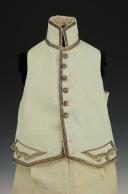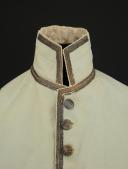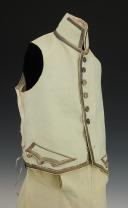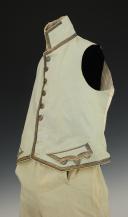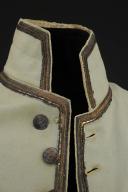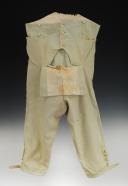
OFFICER'S VEST AND BRIEFS that belonged to Francescu Maria de BACIOCCHI-ADORNO, Principality of Lucca and Piombino, First Empire. 28436/28437
OFFICER'S VEST AND BRIEFS that belonged to Francescu Maria de BACIOCCHI-ADORNO, Principality of Lucca and Piombino, First Empire. 28436/28437
VEST :
Vest in slightly bluish white cloth closing straight at the front with nine silver buttons mounted on bones stamped with a crowned lion. Diameter 1.8 cm. Vest entirely bordered with silver braid in threads, sequins and silver cannetilles, width of the braid 1.1 cm. Collar also edged with this embroidered braid.H from the bottom of the collar to the bottom of the front of the vest 38 cm, H from the bottom of the collar to the bottom of the vest on the sides 42.5 cm. In the lower part of the vest there are two false horizontal pockets with flaps. This flap is embroidered identically to the vest, it forms three points at the bottom, width 14.5 cm, H 4 cm; under this flap, three uniform buttons are sewn. Back of the vest in white cotton canvas, adjustable with laces. Front part of the vest lined with white cotton canvas and ivory silk.
PANTIES:
Breeches with bridge in slightly bluish white cloth with wooden buttons covered with ivory threads. At the front, the fly closes with four buttons, the bridge width part (25 cm, H 17 cm) closes with two side buttons and one of the fly buttons. At the belt level, four buttons (two at the front, two at the back) are intended to hold the straps. On each side of the fly, on the belt, there is a horizontal pocket (9 cm wide). On either side of the fly just below the belt, two horizontal pockets (width approximately 16.5 cm) are placed, each closing with a button on its outer end. At the back of the belt, there is a V-shaped opening lined with white canvas allowing the panties to be adjusted. The bottom of each leg is adjusted by means of four buttons and a tongue and counter-tongue in cloth identical to the pants, one with a button, the other with a buttonhole.
Total height approximately 83 cm. Maximum waist circumference approximately 88 cm.
France.
First Empire.
Very good condition, slight oxidation of the silver embroidery, three buttons missing from the vest, a few small stains and tiny moth holes on the pants, a few moth licks on the surface of the vest. An unstitched button.
ORIGIN :
Vest from the Félix Baciocchi Family.
BIOGRAPHY: Félix BACIOCCHIi.
Born May 18, 1762 in Ajaccio and died April 28, 1841 in Bologna, French prince, is a general of the Empire and French politician of Corsican origin of the 18th and 19th centuries. Husband of Elisa Bonaparte, for whom the principality of Lucca and Piombino was created.
Felix Pascal (without e) was born on May 18, 1762. He belonged to one of the oldest and noblest families of this island and was the youngest son of François-Marie Baciocchi (1716-1787), owner, member of the Council elders from Ajaccio, and Flaminia Benielli (1719-1769). Parent of Joseph Antoine Baciocchi-Adorno who guided him towards a military career, he entered the service very young. He was first second lieutenant in the Royal-Corsica regiment in 1778, then lieutenant in the Corsican royal hunters in 1788, before joining the armies of Var and Italy in 1794. A military man without particular genius, Baciocchi nevertheless came to end of a magnificent conquest: that of Élisa Bonaparte (1777-1820). He was only a simple infantry captain in 1796, when he asked Napoleon Bonaparte, who had just been appointed general in chief of the army of Italy, for the hand of his sister. Napoleon refused: the marriage was nonetheless celebrated in Marseille on May 5, 1797, and General Bonaparte, then in Léoben, accepted the fait accompli.
His career then took a more brilliant turn, although it did not reach the heights reached by that of Joachim Murat, another brother-in-law of Napoleon Bonaparte. General Bonaparte “adopted” his brother-in-law and made him, without having to draw the sword, colonel of the 26th light infantry regiment. He then became a member of the Legion of Honor on 19 Frimaire Year XII then an officer of the same order on the following 25 Prairial.
Arriving at the throne, Napoleon sent him to chair the electoral college of the Ardennes department, which proposed his candidacy for the conservative Senate. The Emperor also made him a member of the Conservative Senate on 8 Frimaire, Year XIII, named him brigadier general on November 11, 1804 and grand cordon of the Legion of Honor on 15 Ventôse of the same year (March 6, 1805).
In 1805, Napoleon wanted to give a crown to his sister Élisa: he offered her the sovereign principality of Piombino by the decree of 27 Ventôse year XIII (March 18, 1805). Shortly after, on 15 Prairial Year XIII (June 4, 1805), the “council of Dukes” (Senate) of the small republic of Lucca asked Napoleon, in his capacity as King of Italy, to entrust the government of the Republic to a member of his family and to make it hereditary in his natural descendants. As a result, Napoleon chose Elisa's husband, Félix Baciocchi, and the choice was ratified by Lucca on Prairial 25 (June 14). Baciocchi was named Prince of Lucca by the constitution of Messidor 4 (June 23). The coronation of Prince Baciocchi and his wife took place on Messidor 12 (July 1, 1805). Recognizing the great superiority of his wife, Baciocchi leaves her complete management of affairs and is content with a role that oscillates between those of aide-de-camp and prince consort. A complacent husband, he tolerates his wife's infidelities with serenity and is satisfied to see her govern the states she holds from the Emperor. In 1809, a senatus-consult of March 2 having elevated the departments of the former kingdom of Etruria to great dignity of the Empire, the Emperor named the Princess of Piombino and Lucca Grand Duchess of Tuscany. The prince was made a major general and commander of the 29th military division in Florence.
Benevolent, humane, gentle, liberal, just, loving and protecting the arts and the most commendable people of letters, Félix Baciocchi leaves, in Tuscany and everywhere where he was known, an honored memory. Talleyrand has one of his cruel words towards him: the prince, dispossessed of Piombino, complains of no longer knowing which name to take: "Take that of Baciocchi, it is vacant", replies the Minister of External Relations. While his absence from Paris saved him from having to vote for the fall of the Emperor with the rest of the Senate (1814), Félix Baciocchi felt the need to publish a proclamation by which he supported this decision.
BIOGRAPHY: BACIOCCHI-ADORNO (de) Francescu Maria (BACIOCHI Franceschinu): (1776-1861)
Born in Aiacciu. Son of Ghjuseppe Antoniu. Consul general of Genoa in Corsica in 1803. Colonel first aide-de-camp to the Prince of Lucca and Piombino in 1806. Colonel of the noble guards of the Grand Duchess of Tuscany in 1808. Commander of the Royal Order of the Union of Holland. Authorized, by royal decree, to add to his name that of Adorno, and to be called Baciocchi Adorno, in 1817. Mayor of Aiacciu from 1817 to 1819. In 1818, he was a corresponding member of the Society of Public Education of the Department of Corsica. Member of the Central Agricultural Society of Corsica. Knight of the Legion of Honour.
THANKS :
I thank Mr Bruno Mugnai, for his work on the uniforms of the Principality of Lucca and Piombino.
HISTORY:
By Mr Bruno Mugnai.
Small and practically disarmed, the principality of Lucca and Piombino inaugurated a series of States entrusted to those close to Napoleon. In 1805, the ancient principality of southern Tuscany, which already belonged to the Boncompagni-Ludovisi family, was ceded to Felice Baciocchi, husband of the emperor's sister, Elisa Bonaparte. A few weeks later, on June 12, 1805, the Democratic Republic of Lucca demanded that Napoleon receive Prince Felice Baciocchi and his wife as its new rulers. Thus, a new state was born, consisting of the strategic outpost of Piombino, which guarded the Elbe Canal, and the city-state of Lucca, where the new court resided. The creation of this State is not the result of chance. Napoleon always viewed Italy as a political laboratory for introducing new systems of power and experimenting with methods of government. The kingdoms of Italy and Naples were consolidated in the new order and Italian became the second language of the Empire. 4,800,000 Italians lived in the new French departments created on the Peninsula, called France-Italienne (Italians represented in 1809 approximately 11% of the entire imperial population; see in Roger Dufraisse, The Role of Italy in Napoleonic Politics , p. 41, in the Acts of the Congress 'Il Principato Napoleonico dei Baciocchi, Lucca, 1984). Furthermore, after 1806, there existed in Italy 22 duchies, 2 principalities and other important fiefs (12 fiefs in the Kingdom of Italy, 4 in the Kingdom of Naples and 3 others included in the territory of Parma and Piacenza) attributed to the Bonaparte family and the most valiant military leaders. These new states clearly indicate that, for Napoleon, no Frenchman could govern the Empire better than his brothers, thus ensuring the hegemonic policy announced since 1804.
Naturally, the existence of a small state like Lucca and Piombino was guaranteed by total obedience to the Napoleonic order, as the rapid involvement of the Republic of Lucca in the French continental blockade against England in 1803 clearly demonstrates. Despite its limited sovereignty, the Principality of Lucca and Piombino stood out as the only state in the French Empire where military conscription remained unknown. The Baciocchi princes seemed to rule on an island in Napoleon's stormy ocean, and their experience represented a considerable change in the history of the two states. The rise of the Corsican Felice Baciocchi in Napoleonic Parnassus was due in large part to the ability and initiative of his wife Elisa. She possessed extraordinary organizational skills, an undeniable talent for economic issues and tireless energy. Contemporaries recognized these qualities and she earned the nickname “La Femme Napoléon”. Elisa's enlightened policies promoted effective delivery in public institutions and, as a result, Lucca became an important cultural center in Italy.
Despite the Principality's modest military strength, the princes reorganized the small army by raising new units and reforming the militia. In 1806 the army consisted of the Prince Felice Battalion, five companies of light infantry, additional soldiers from Piombino who made up almost a quarter of the battalion, two companies of outnumbered artillery, one company gendarmerie, which included seven mounted gendarmes, and a company of veterans in garrison. in Lucca. The line army numbered 828 men³³, while “on paper, 20,000 additional militiamen could be enlisted by the State”. 168 other men secured the residences of the sovereigns and their escorts. This unit, created in 1806, was inspired by the French Imperial Guard.
Despite the Principality's modest military strength, the princes reorganized the small army by raising new units and reforming the militia. In 1806 the army consisted of the Prince Felice Battalion, five companies of light infantry, additional soldiers from Piombino who made up almost a quarter of the battalion, two companies of outnumbered artillery, one company of gendarmerie, which included seven mounted gendarmes, and a company of veterans in garrison. in Lucca. The line army numbered 828 men, while "on paper, 20,000 additional militiamen could be enlisted by the State." 168 other men secured the residences of the sovereigns and their escorts. This unit, created in 1806, was inspired by the French Imperial Guard.
Prince Felice Baciocchi recognized the first company of the Guardia del Corpo on April 29, 1806 and on May 1 the first company of 78 private grenadiers, non-commissioned officers and officers entered service in Lucca. The decree also established a minimum unit height, 5 feet and 4 inches (177 cm). The formation of the company required the withdrawal of some troops from the line battalion's grenadier company. Previously, on April 30, the old Swiss Guards company was disbanded and, little by little, like tiles in a mosaic, Swiss Guards under the age of 50 completed the new unit. Only 14 soldiers, 2 non-commissioned officers and 1 officer could be enlisted in the company, while another 50 soldiers came from the infantry stationed in Lucca and Piombino. The enterprise was finally completed in January 1807, when the prince appointed the officers. In the same period, another company of equal size was created, called Compagnia Cacciatori. The Prince's secretary administered the Guards, a unit belonging to the House of Princes and directly commanded by Prince Félice, classified as a Division General in the French Army by his contemporaries. As expected for a unit created for the safety of the Prince, the Rescuer received the greatest care: a high salary and top quality equipment. Finally, in January 1807, the commander, Inspector General Mariotti, informed the prince that "... the Gardes du Corps have withdrawn all the weapons intended for them."
While the service entrusted to the Guards certainly lacked risk, it was also less stimulating. The main tasks were carried out at the Government Palace of Lucca and in the princely residence of Marlia where he stationed 4 soldiers and 1 officer. Mainly due to his presence, or absence, in his residence, the prince eventually altered the composition of the Marlia unit. After the principality of Baciocchi absorbed the territory of the former Duchy of Apuanes, another detachment of bodyguards was formed for the residence of the sovereigns in Massa in September 1807. The new unit consisted of 1 sergeant, 2 corporals, 1 drum and 20 grenadiers. Command alternated between 1 Lieutenant of the Grenadiers and 1 of the Hunters, who had under his command 1 Sergeant, 1 Corporal, 1 Musician, but only 8 soldiers. Additionally, when older members resigned at the end of the year, the Corps' strength declined further and the gaps were only partially filled by other troops. A large portion of the Italian and Corsican soldiers remained in the ranks, but soldiers with unmistakably French names were also enlisted.
Despite the attention and care given to the Guards, in June 1807, 14 hunters deserted simultaneously. Mariotti informed Prince Félice of this unpleasant episode, which only concerned Corsican soldiers. To prevent the fugitives from embarking for Corsica, the commander passed a note to the French authorities in Livorno and provided a brief physical description of the deserters. The port of Viareggio was also alarmed and other dispatches were sent to Pisa, Florence and even Corsica. Finally, on July 21, the French gendarmerie informed Mariotti that Corporal Colonna, the instigator of the desertion, had been arrested in Ajaccio. Despite the recommendation to recover uniforms and equipment, nothing was found.
The outcome of the desertion left a visible mark on the guards. The Grenadier Company review of June 20, 1807 recorded 4 officers, 6 non-commissioned officers, 8 corporals, 3 drummers and 53 soldiers; while in the Company of Hunters, there remained 3 officers, 5 non-commissioned officers, 7 corporals, 3 drummers and only 35 soldiers. Periodic resignations requested by soldiers also reduced the unit's strength. From 1808 to 1813, resignations were granted for reasons of retirement, illness and for voluntary transfer to other units. In July 1807, barely a year after the formation of the unit, 6 guards were already transferred to the Gendarmerie. Periodically, after the satisfactory completion of service in the Guards, other transfers were registered. These transfers were generally directed to the line infantry, where each guard could request to increase their rank. In such cases, a guard was given a position immediately higher than the rank he held in his original unit. However, when these rotations took place, other movements took place in other units, notably in the line battalion and in the gendarmerie. Simultaneous movements were an obvious consequence of a small army, where the possibilities of moving up the ranks remained very low.
After Élisa Bonaparte-Baciocchi was named Grand Duchess of Tuscany in July 1809, the bodyguards had the honor of escorting the sovereign to Florence. By a communication sent by the Secretary of State, the prince ordered the troops stationed in Marlia and Lucca to assemble in the Tuscan capital. On the morning of July 12, the guards marched and, with a one-day stop in Pistoia, covered the distance in three and a half days.
As the two princes resided more and more in Florence, the functions of the guards diminished. Combined with the difficulties encountered in maintaining the strength of the companies, the government was forced to reform the entire corps. The decree of August 30, 1810 merged the two companies: 1 captain commander, 1 deputy captain, 1 first lieutenant, 1 second lieutenant, 2 second lieutenants, 1 quartermaster sergeant, 1 sergeant major, 4 sergeants, 1 quartermaster corporal, 2 drums, and 48 guards. In October, the strength was increased to 75 men with 22 soldiers and 5 additional non-commissioned officers6. The new unit became known as the Compagnia delle Guardie del Corpo di Sua Altezza Serenissima.
During the winter of 1813-14, a plan was presented to reform the company to 78 men under the command of Lieutenant Colonel Giacomo Maestroni. This Corsican officer had commanded the line battalion and arrived in the Principality alongside the Baciocchi family. This transformation of the Guards was only partially completed. On the eve of the Neapolitan occupation, the company had a higher strength, totaling 95 soldiers, 6 non-commissioned officers and 4 officers. In March, when the last company commander, Lieutenant Sebastiano Donati, reviewed the guards for the last time, his forces numbered 68 men in Lucca, another 29 stationed in Marlia, 1 officer and 1 non-commissioned officer assigned to Florence at Prince Felice's staff, 4 soldiers hospitalized and 2 others assigned to other tasks. On March 19, 1814, a Neapolitan colonel, Count Gaetani, requested the delivery of all weapons, equipment and uniforms. Deprived of any external military sign, the Life Guards ceased to exist.
Important French scholars and historians, such as Paul Marmottan, were interested in the military history of the principality of Lucca and Piombino. This influential member of the Sabretache traveled to Tuscany on several occasions in search of objects and information concerning the soldiers of the Principality¹9. After Marmottan, Roger Forthoffer discovered other important details concerning the uniforms of Prince Baciocchi's small army. Both authors demonstrated great interest in the Napoleonic history of Lucca and Piombino – regions which contrasted sharply with the rest of France's ruling Europe, yet contained an ambivalent respect for the imperial order. In many respects, the Principality of Lucca and Piombino had been: "the most 'French' of the Italian States and perhaps more 'Napoleonic' than France".
Sometimes the idea that military uniforms have some sort of relationship to the society that created them is extremely clear. The difficulty, however, is untangling the many threads that connect these objects to the institutions that designed and produced them. In many ways, the choice of colors for the Life Guard Company uniforms encrypted a signal of self-determination. Brightly colored uniforms, designed by the prestigious scenographer and painter Jean-Baptiste Isabey, were manufactured for these units. For Princess Elisa, these colors provided a worthy setting for her court, which she wanted from the beginning to appear magnificent and sumptuous. The characteristics of this uniform perhaps followed the same model as that of the French Imperial Guard, but with colors very different from those normally used in the Empire. Perhaps scarlet red and pistachio green could be attributed to Elisa's personal tastes, but at the same time, these colors proclaimed a state determined to emphasize its political and cultural autonomy within the French order.
As is typical in old documents, even in documents from the 19th century, details and descriptions regarding uniform costs, but not always colors and shapes, are explained. The guards' uniform is well described in the Bulletin of Laws and Decrees of the Principality2, but the lack of precision on accessories and other details forces us to resort to comparisons and suppositions. Furthermore, there is no pictorial proof of the guards of the Principality, and concerning the accessories, the text only specifies: "to be taken from the models". Even when the second company is created, poor information persists. Despite the uncertainties, the bearskin cap and equipment could be related to objects of the French Imperial Guard. Likewise, the uniform model of the Compagnia Cacciatori could have followed the line of the light infantry coat-jacket. Fortunately, some discoveries in state archives reveal other significant stories about this uniform. A memorandum attached to a document from the Secretary of State indicates that white metal buttons with the emblem of the Panther, symbol of the old Republic of Lucca, had been recovered from the coats of the disbanded Swiss Guards and were intended for the new Guards uniforms.
Another document discovered in the archives recounts a change of uniform in 1812. Some letters sent to Florence during the winter of 1811-1812 contained plans submitted to Prince Felice regarding the new company of bodyguards. Unfortunately, the unintelligible writing obscures what colors would be chosen, but it is certain that the uniform has undergone significant changes. Two years later, thanks to a note attached to the documentation concerning the requisitions ordered by the Neapolitan occupiers, we learned that the Company was dressed entirely in white with carmine red facings. Hypothetically, this change is confirmed in an otherwise unidentified source showing a front and back uniform model with some peculiar elements. The grenadier's bearskin headgear bore a brass plate with a panther, the same distinctive symbol that appeared in 1806. Once again, the link with the past as a political declaration of autonomy had not disappeared.
VEST :
Vest in slightly bluish white cloth closing straight at the front with nine silver buttons mounted on bones stamped with a crowned lion. Diameter 1.8 cm. Vest entirely bordered with silver braid in threads, sequins and silver cannetilles, width of the braid 1.1 cm. Collar also edged with this embroidered braid.H from the bottom of the collar to the bottom of the front of the vest 38 cm, H from the bottom of the collar to the bottom of the vest on the sides 42.5 cm. In the lower part of the vest there are two false horizontal pockets with flaps. This flap is embroidered identically to the vest, it forms three points at the bottom, width 14.5 cm, H 4 cm; under this flap, three uniform buttons are sewn. Back of the vest in white cotton canvas, adjustable with laces. Front part of the vest lined with white cotton canvas and ivory silk.
PANTIES:
Breeches with bridge in slightly bluish white cloth with wooden buttons covered with ivory threads. At the front, the fly closes with four buttons, the bridge width part (25 cm, H 17 cm) closes with two side buttons and one of the fly buttons. At the belt level, four buttons (two at the front, two at the back) are intended to hold the straps. On each side of the fly, on the belt, there is a horizontal pocket (9 cm wide). On either side of the fly just below the belt, two horizontal pockets (width approximately 16.5 cm) are placed, each closing with a button on its outer end. At the back of the belt, there is a V-shaped opening lined with white canvas allowing the panties to be adjusted. The bottom of each leg is adjusted by means of four buttons and a tongue and counter-tongue in cloth identical to the pants, one with a button, the other with a buttonhole.
Total height approximately 83 cm. Maximum waist circumference approximately 88 cm.
France.
First Empire.
Very good condition, slight oxidation of the silver embroidery, three buttons missing from the vest, a few small stains and tiny moth holes on the pants, a few moth licks on the surface of the vest. An unstitched button.
ORIGIN :
Vest from the Félix Baciocchi Family.
BIOGRAPHY: Félix BACIOCCHIi.
Born May 18, 1762 in Ajaccio and died April 28, 1841 in Bologna, French prince, is a general of the Empire and French politician of Corsican origin of the 18th and 19th centuries. Husband of Elisa Bonaparte, for whom the principality of Lucca and Piombino was created.
Felix Pascal (without e) was born on May 18, 1762. He belonged to one of the oldest and noblest families of this island and was the youngest son of François-Marie Baciocchi (1716-1787), owner, member of the Council elders from Ajaccio, and Flaminia Benielli (1719-1769). Parent of Joseph Antoine Baciocchi-Adorno who guided him towards a military career, he entered the service very young. He was first second lieutenant in the Royal-Corsica regiment in 1778, then lieutenant in the Corsican royal hunters in 1788, before joining the armies of Var and Italy in 1794. A military man without particular genius, Baciocchi nevertheless came to end of a magnificent conquest: that of Élisa Bonaparte (1777-1820). He was only a simple infantry captain in 1796, when he asked Napoleon Bonaparte, who had just been appointed general in chief of the army of Italy, for the hand of his sister. Napoleon refused: the marriage was nonetheless celebrated in Marseille on May 5, 1797, and General Bonaparte, then in Léoben, accepted the fait accompli.
His career then took a more brilliant turn, although it did not reach the heights reached by that of Joachim Murat, another brother-in-law of Napoleon Bonaparte. General Bonaparte “adopted” his brother-in-law and made him, without having to draw the sword, colonel of the 26th light infantry regiment. He then became a member of the Legion of Honor on 19 Frimaire Year XII then an officer of the same order on the following 25 Prairial.
Arriving at the throne, Napoleon sent him to chair the electoral college of the Ardennes department, which proposed his candidacy for the conservative Senate. The Emperor also made him a member of the Conservative Senate on 8 Frimaire, Year XIII, named him brigadier general on November 11, 1804 and grand cordon of the Legion of Honor on 15 Ventôse of the same year (March 6, 1805).
In 1805, Napoleon wanted to give a crown to his sister Élisa: he offered her the sovereign principality of Piombino by the decree of 27 Ventôse year XIII (March 18, 1805). Shortly after, on 15 Prairial Year XIII (June 4, 1805), the “council of Dukes” (Senate) of the small republic of Lucca asked Napoleon, in his capacity as King of Italy, to entrust the government of the Republic to a member of his family and to make it hereditary in his natural descendants. As a result, Napoleon chose Elisa's husband, Félix Baciocchi, and the choice was ratified by Lucca on Prairial 25 (June 14). Baciocchi was named Prince of Lucca by the constitution of Messidor 4 (June 23). The coronation of Prince Baciocchi and his wife took place on Messidor 12 (July 1, 1805). Recognizing the great superiority of his wife, Baciocchi leaves her complete management of affairs and is content with a role that oscillates between those of aide-de-camp and prince consort. A complacent husband, he tolerates his wife's infidelities with serenity and is satisfied to see her govern the states she holds from the Emperor. In 1809, a senatus-consult of March 2 having elevated the departments of the former kingdom of Etruria to great dignity of the Empire, the Emperor named the Princess of Piombino and Lucca Grand Duchess of Tuscany. The prince was made a major general and commander of the 29th military division in Florence.
Benevolent, humane, gentle, liberal, just, loving and protecting the arts and the most commendable people of letters, Félix Baciocchi leaves, in Tuscany and everywhere where he was known, an honored memory. Talleyrand has one of his cruel words towards him: the prince, dispossessed of Piombino, complains of no longer knowing which name to take: "Take that of Baciocchi, it is vacant", replies the Minister of External Relations. While his absence from Paris saved him from having to vote for the fall of the Emperor with the rest of the Senate (1814), Félix Baciocchi felt the need to publish a proclamation by which he supported this decision.
BIOGRAPHY: BACIOCCHI-ADORNO (de) Francescu Maria (BACIOCHI Franceschinu): (1776-1861)
Born in Aiacciu. Son of Ghjuseppe Antoniu. Consul general of Genoa in Corsica in 1803. Colonel first aide-de-camp to the Prince of Lucca and Piombino in 1806. Colonel of the noble guards of the Grand Duchess of Tuscany in 1808. Commander of the Royal Order of the Union of Holland. Authorized, by royal decree, to add to his name that of Adorno, and to be called Baciocchi Adorno, in 1817. Mayor of Aiacciu from 1817 to 1819. In 1818, he was a corresponding member of the Society of Public Education of the Department of Corsica. Member of the Central Agricultural Society of Corsica. Knight of the Legion of Honour.
THANKS :
I thank Mr Bruno Mugnai, for his work on the uniforms of the Principality of Lucca and Piombino.
HISTORY:
By Mr Bruno Mugnai.
Small and practically disarmed, the principality of Lucca and Piombino inaugurated a series of States entrusted to those close to Napoleon. In 1805, the ancient principality of southern Tuscany, which already belonged to the Boncompagni-Ludovisi family, was ceded to Felice Baciocchi, husband of the emperor's sister, Elisa Bonaparte. A few weeks later, on June 12, 1805, the Democratic Republic of Lucca demanded that Napoleon receive Prince Felice Baciocchi and his wife as its new rulers. Thus, a new state was born, consisting of the strategic outpost of Piombino, which guarded the Elbe Canal, and the city-state of Lucca, where the new court resided. The creation of this State is not the result of chance. Napoleon always viewed Italy as a political laboratory for introducing new systems of power and experimenting with methods of government. The kingdoms of Italy and Naples were consolidated in the new order and Italian became the second language of the Empire. 4,800,000 Italians lived in the new French departments created on the Peninsula, called France-Italienne (Italians represented in 1809 approximately 11% of the entire imperial population; see in Roger Dufraisse, The Role of Italy in Napoleonic Politics , p. 41, in the Acts of the Congress 'Il Principato Napoleonico dei Baciocchi, Lucca, 1984). Furthermore, after 1806, there existed in Italy 22 duchies, 2 principalities and other important fiefs (12 fiefs in the Kingdom of Italy, 4 in the Kingdom of Naples and 3 others included in the territory of Parma and Piacenza) attributed to the Bonaparte family and the most valiant military leaders. These new states clearly indicate that, for Napoleon, no Frenchman could govern the Empire better than his brothers, thus ensuring the hegemonic policy announced since 1804.
Naturally, the existence of a small state like Lucca and Piombino was guaranteed by total obedience to the Napoleonic order, as the rapid involvement of the Republic of Lucca in the French continental blockade against England in 1803 clearly demonstrates. Despite its limited sovereignty, the Principality of Lucca and Piombino stood out as the only state in the French Empire where military conscription remained unknown. The Baciocchi princes seemed to rule on an island in Napoleon's stormy ocean, and their experience represented a considerable change in the history of the two states. The rise of the Corsican Felice Baciocchi in Napoleonic Parnassus was due in large part to the ability and initiative of his wife Elisa. She possessed extraordinary organizational skills, an undeniable talent for economic issues and tireless energy. Contemporaries recognized these qualities and she earned the nickname “La Femme Napoléon”. Elisa's enlightened policies promoted effective delivery in public institutions and, as a result, Lucca became an important cultural center in Italy.
Despite the Principality's modest military strength, the princes reorganized the small army by raising new units and reforming the militia. In 1806 the army consisted of the Prince Felice Battalion, five companies of light infantry, additional soldiers from Piombino who made up almost a quarter of the battalion, two companies of outnumbered artillery, one company gendarmerie, which included seven mounted gendarmes, and a company of veterans in garrison. in Lucca. The line army numbered 828 men³³, while “on paper, 20,000 additional militiamen could be enlisted by the State”. 168 other men secured the residences of the sovereigns and their escorts. This unit, created in 1806, was inspired by the French Imperial Guard.
Despite the Principality's modest military strength, the princes reorganized the small army by raising new units and reforming the militia. In 1806 the army consisted of the Prince Felice Battalion, five companies of light infantry, additional soldiers from Piombino who made up almost a quarter of the battalion, two companies of outnumbered artillery, one company of gendarmerie, which included seven mounted gendarmes, and a company of veterans in garrison. in Lucca. The line army numbered 828 men, while "on paper, 20,000 additional militiamen could be enlisted by the State." 168 other men secured the residences of the sovereigns and their escorts. This unit, created in 1806, was inspired by the French Imperial Guard.
Prince Felice Baciocchi recognized the first company of the Guardia del Corpo on April 29, 1806 and on May 1 the first company of 78 private grenadiers, non-commissioned officers and officers entered service in Lucca. The decree also established a minimum unit height, 5 feet and 4 inches (177 cm). The formation of the company required the withdrawal of some troops from the line battalion's grenadier company. Previously, on April 30, the old Swiss Guards company was disbanded and, little by little, like tiles in a mosaic, Swiss Guards under the age of 50 completed the new unit. Only 14 soldiers, 2 non-commissioned officers and 1 officer could be enlisted in the company, while another 50 soldiers came from the infantry stationed in Lucca and Piombino. The enterprise was finally completed in January 1807, when the prince appointed the officers. In the same period, another company of equal size was created, called Compagnia Cacciatori. The Prince's secretary administered the Guards, a unit belonging to the House of Princes and directly commanded by Prince Félice, classified as a Division General in the French Army by his contemporaries. As expected for a unit created for the safety of the Prince, the Rescuer received the greatest care: a high salary and top quality equipment. Finally, in January 1807, the commander, Inspector General Mariotti, informed the prince that "... the Gardes du Corps have withdrawn all the weapons intended for them."
While the service entrusted to the Guards certainly lacked risk, it was also less stimulating. The main tasks were carried out at the Government Palace of Lucca and in the princely residence of Marlia where he stationed 4 soldiers and 1 officer. Mainly due to his presence, or absence, in his residence, the prince eventually altered the composition of the Marlia unit. After the principality of Baciocchi absorbed the territory of the former Duchy of Apuanes, another detachment of bodyguards was formed for the residence of the sovereigns in Massa in September 1807. The new unit consisted of 1 sergeant, 2 corporals, 1 drum and 20 grenadiers. Command alternated between 1 Lieutenant of the Grenadiers and 1 of the Hunters, who had under his command 1 Sergeant, 1 Corporal, 1 Musician, but only 8 soldiers. Additionally, when older members resigned at the end of the year, the Corps' strength declined further and the gaps were only partially filled by other troops. A large portion of the Italian and Corsican soldiers remained in the ranks, but soldiers with unmistakably French names were also enlisted.
Despite the attention and care given to the Guards, in June 1807, 14 hunters deserted simultaneously. Mariotti informed Prince Félice of this unpleasant episode, which only concerned Corsican soldiers. To prevent the fugitives from embarking for Corsica, the commander passed a note to the French authorities in Livorno and provided a brief physical description of the deserters. The port of Viareggio was also alarmed and other dispatches were sent to Pisa, Florence and even Corsica. Finally, on July 21, the French gendarmerie informed Mariotti that Corporal Colonna, the instigator of the desertion, had been arrested in Ajaccio. Despite the recommendation to recover uniforms and equipment, nothing was found.
The outcome of the desertion left a visible mark on the guards. The Grenadier Company review of June 20, 1807 recorded 4 officers, 6 non-commissioned officers, 8 corporals, 3 drummers and 53 soldiers; while in the Company of Hunters, there remained 3 officers, 5 non-commissioned officers, 7 corporals, 3 drummers and only 35 soldiers. Periodic resignations requested by soldiers also reduced the unit's strength. From 1808 to 1813, resignations were granted for reasons of retirement, illness and for voluntary transfer to other units. In July 1807, barely a year after the formation of the unit, 6 guards were already transferred to the Gendarmerie. Periodically, after the satisfactory completion of service in the Guards, other transfers were registered. These transfers were generally directed to the line infantry, where each guard could request to increase their rank. In such cases, a guard was given a position immediately higher than the rank he held in his original unit. However, when these rotations took place, other movements took place in other units, notably in the line battalion and in the gendarmerie. Simultaneous movements were an obvious consequence of a small army, where the possibilities of moving up the ranks remained very low.
After Élisa Bonaparte-Baciocchi was named Grand Duchess of Tuscany in July 1809, the bodyguards had the honor of escorting the sovereign to Florence. By a communication sent by the Secretary of State, the prince ordered the troops stationed in Marlia and Lucca to assemble in the Tuscan capital. On the morning of July 12, the guards marched and, with a one-day stop in Pistoia, covered the distance in three and a half days.
As the two princes resided more and more in Florence, the functions of the guards diminished. Combined with the difficulties encountered in maintaining the strength of the companies, the government was forced to reform the entire corps. The decree of August 30, 1810 merged the two companies: 1 captain commander, 1 deputy captain, 1 first lieutenant, 1 second lieutenant, 2 second lieutenants, 1 quartermaster sergeant, 1 sergeant major, 4 sergeants, 1 quartermaster corporal, 2 drums, and 48 guards. In October, the strength was increased to 75 men with 22 soldiers and 5 additional non-commissioned officers6. The new unit became known as the Compagnia delle Guardie del Corpo di Sua Altezza Serenissima.
During the winter of 1813-14, a plan was presented to reform the company to 78 men under the command of Lieutenant Colonel Giacomo Maestroni. This Corsican officer had commanded the line battalion and arrived in the Principality alongside the Baciocchi family. This transformation of the Guards was only partially completed. On the eve of the Neapolitan occupation, the company had a higher strength, totaling 95 soldiers, 6 non-commissioned officers and 4 officers. In March, when the last company commander, Lieutenant Sebastiano Donati, reviewed the guards for the last time, his forces numbered 68 men in Lucca, another 29 stationed in Marlia, 1 officer and 1 non-commissioned officer assigned to Florence at Prince Felice's staff, 4 soldiers hospitalized and 2 others assigned to other tasks. On March 19, 1814, a Neapolitan colonel, Count Gaetani, requested the delivery of all weapons, equipment and uniforms. Deprived of any external military sign, the Life Guards ceased to exist.
Important French scholars and historians, such as Paul Marmottan, were interested in the military history of the principality of Lucca and Piombino. This influential member of the Sabretache traveled to Tuscany on several occasions in search of objects and information concerning the soldiers of the Principality¹9. After Marmottan, Roger Forthoffer discovered other important details concerning the uniforms of Prince Baciocchi's small army. Both authors demonstrated great interest in the Napoleonic history of Lucca and Piombino – regions which contrasted sharply with the rest of France's ruling Europe, yet contained an ambivalent respect for the imperial order. In many respects, the Principality of Lucca and Piombino had been: "the most 'French' of the Italian States and perhaps more 'Napoleonic' than France".
Sometimes the idea that military uniforms have some sort of relationship to the society that created them is extremely clear. The difficulty, however, is untangling the many threads that connect these objects to the institutions that designed and produced them. In many ways, the choice of colors for the Life Guard Company uniforms encrypted a signal of self-determination. Brightly colored uniforms, designed by the prestigious scenographer and painter Jean-Baptiste Isabey, were manufactured for these units. For Princess Elisa, these colors provided a worthy setting for her court, which she wanted from the beginning to appear magnificent and sumptuous. The characteristics of this uniform perhaps followed the same model as that of the French Imperial Guard, but with colors very different from those normally used in the Empire. Perhaps scarlet red and pistachio green could be attributed to Elisa's personal tastes, but at the same time, these colors proclaimed a state determined to emphasize its political and cultural autonomy within the French order.
As is typical in old documents, even in documents from the 19th century, details and descriptions regarding uniform costs, but not always colors and shapes, are explained. The guards' uniform is well described in the Bulletin of Laws and Decrees of the Principality2, but the lack of precision on accessories and other details forces us to resort to comparisons and suppositions. Furthermore, there is no pictorial proof of the guards of the Principality, and concerning the accessories, the text only specifies: "to be taken from the models". Even when the second company is created, poor information persists. Despite the uncertainties, the bearskin cap and equipment could be related to objects of the French Imperial Guard. Likewise, the uniform model of the Compagnia Cacciatori could have followed the line of the light infantry coat-jacket. Fortunately, some discoveries in state archives reveal other significant stories about this uniform. A memorandum attached to a document from the Secretary of State indicates that white metal buttons with the emblem of the Panther, symbol of the old Republic of Lucca, had been recovered from the coats of the disbanded Swiss Guards and were intended for the new Guards uniforms.
Another document discovered in the archives recounts a change of uniform in 1812. Some letters sent to Florence during the winter of 1811-1812 contained plans submitted to Prince Felice regarding the new company of bodyguards. Unfortunately, the unintelligible writing obscures what colors would be chosen, but it is certain that the uniform has undergone significant changes. Two years later, thanks to a note attached to the documentation concerning the requisitions ordered by the Neapolitan occupiers, we learned that the Company was dressed entirely in white with carmine red facings. Hypothetically, this change is confirmed in an otherwise unidentified source showing a front and back uniform model with some peculiar elements. The grenadier's bearskin headgear bore a brass plate with a panther, the same distinctive symbol that appeared in 1806. Once again, the link with the past as a political declaration of autonomy had not disappeared.
Price :
4 000,00 €
| Destination | Envoi recommandé | Envoi Recommandé + Express |
|---|---|---|
| Shipping France | 13,00 € | 40,00 € |
| Shipping Europe | 18,00 € | 60,00 € |
| Shipping world | 35,00 € | 90,00 € |
Insurance (1%) :
40,00 €
Reference :
28436/28437
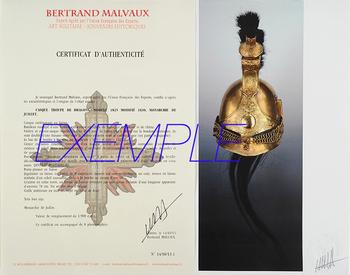
Next update Friday, december 26 at 13:30 PM
FOR ALL PURCHASES, PAYMENT IN MULTIPLE CHECKS POSSIBLE
bertrand.malvaux@wanadoo.fr 06 07 75 74 63
SHIPPING COSTS
Shipping costs are calculated only once per order for one or more items, all shipments are sent via registered mail, as this is the only way to have proof of dispatch and receipt.
For parcels whose value cannot be insured by the Post, shipments are entrusted to DHL or Fedex with real value insured, the service is of high quality but the cost is higher.
RETURN POLICY
Items can be returned within 8 days of receipt. They must be returned by registered mail at the sender's expense, in their original packaging, and in their original condition.
AUTHENTICITY
The selection of items offered on this site allows me to guarantee the authenticity of each piece described here, all items offered are guaranteed to be period and authentic, unless otherwise noted or restricted in the description.
An authenticity certificate of the item including the description published on the site, the period, the sale price, accompanied by one or more color photographs is automatically provided for any item priced over 130 euros. Below this price, each certificate is charged 5 euros.
Only items sold by me are subject to an authenticity certificate, I do not provide any expert reports for items sold by third parties (colleagues or collectors).
FOR ALL PURCHASES, PAYMENT IN MULTIPLE CHECKS POSSIBLE
bertrand.malvaux@wanadoo.fr 06 07 75 74 63
An authenticity certificate of the item including the description published on the site, the period, the sale price, accompanied by one or more color photographs is automatically provided for any item priced over 130 euros. Below this price, each certificate is charged 5 euros.
Only items sold by me are subject to an authenticity certificate, I do not provide any expert reports for items sold by third parties (colleagues or collectors).
